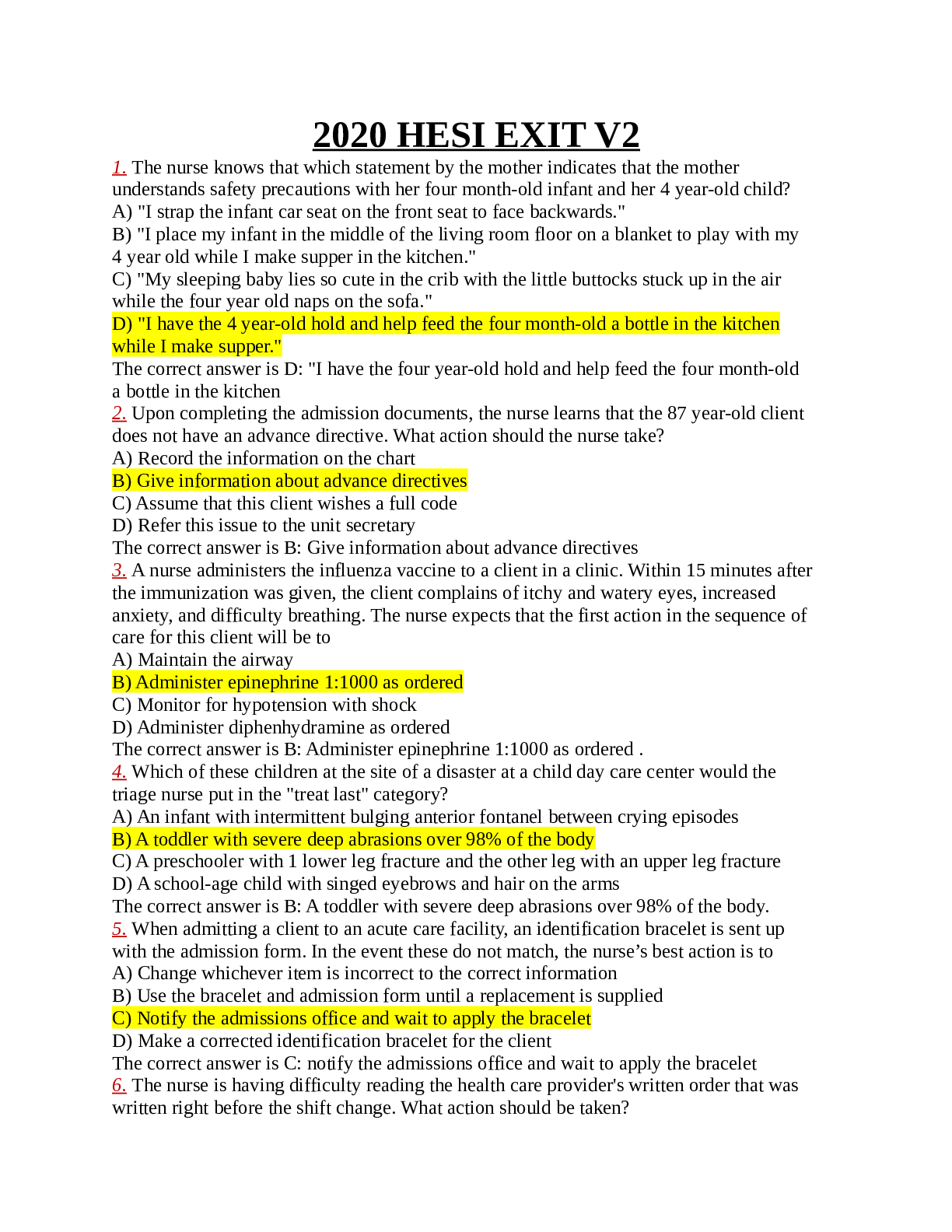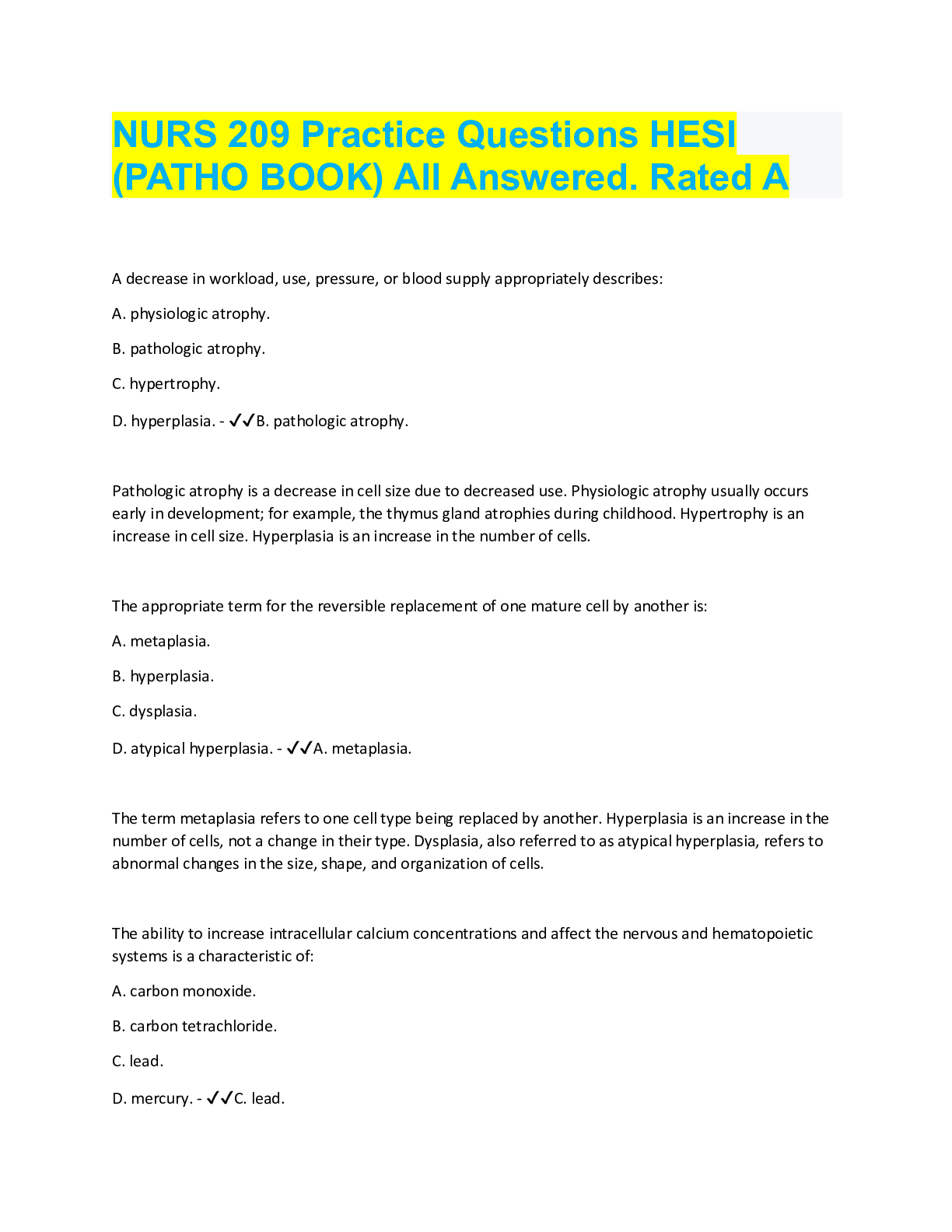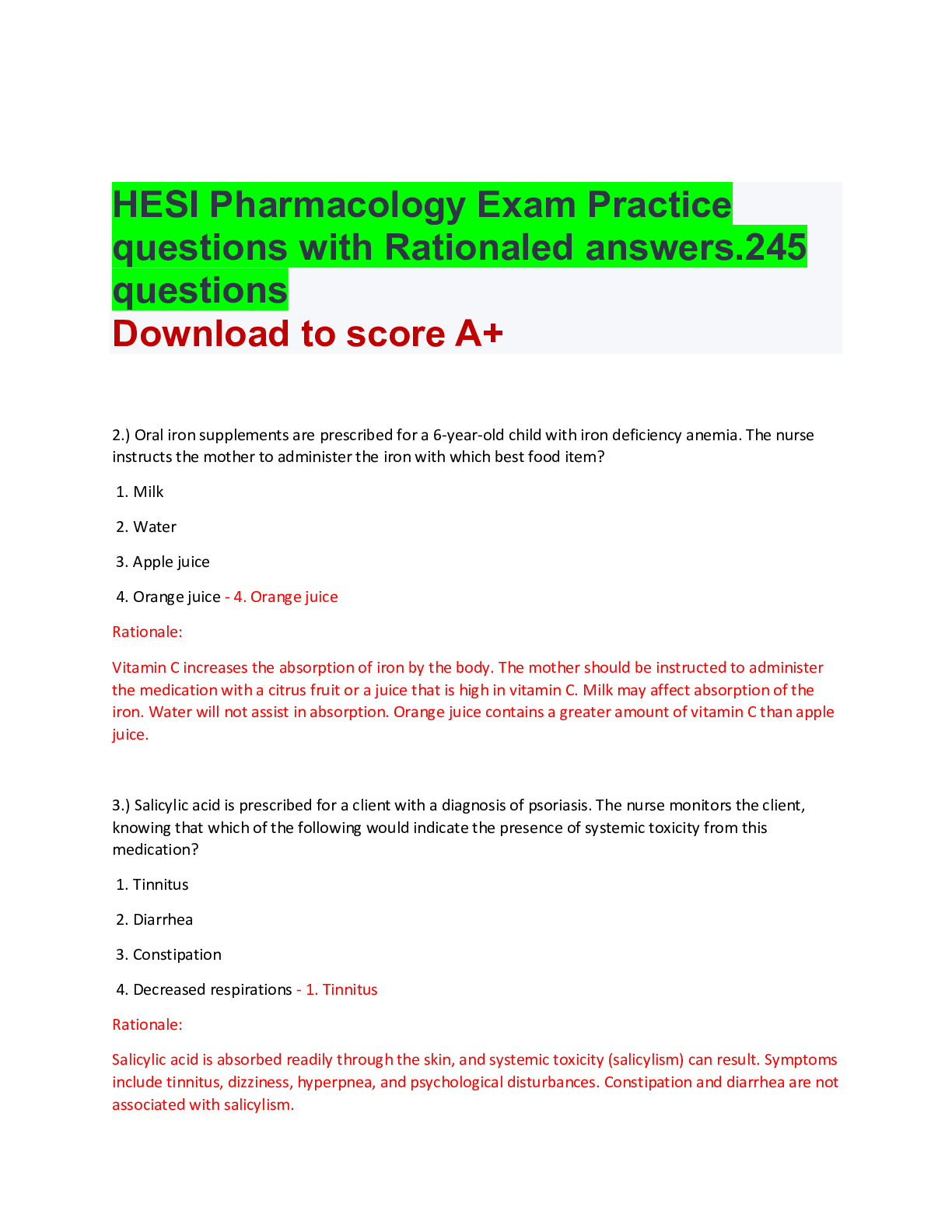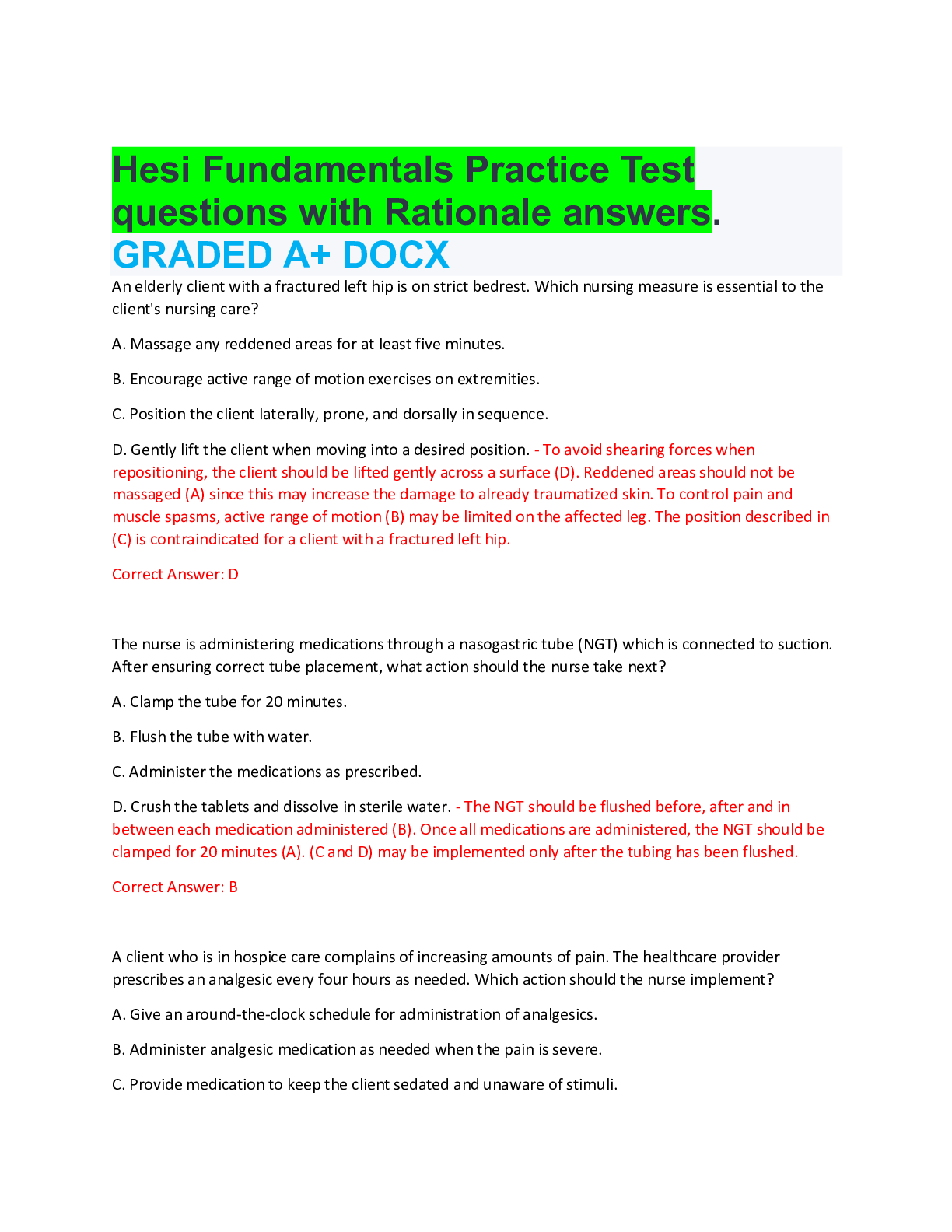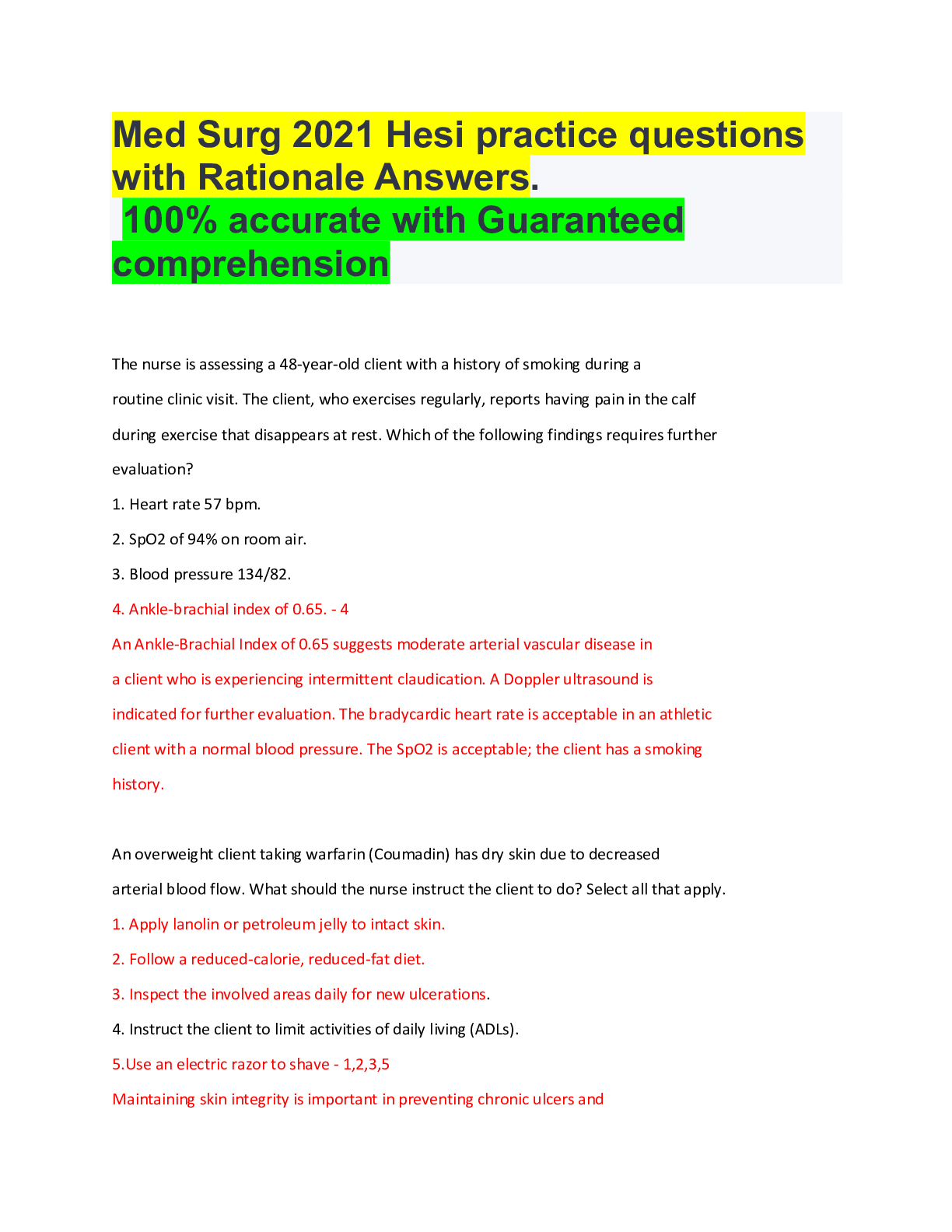HESI 700. Questions with Rationale Answers. LATEST 2022/2023. EXAM PREVIEW.
Document Content and Description Below
Following discharge teaching, a male client with duodenal ulcer tells the nurse the he will drink plenty of dairy products, such as milk, to help coat and protect his ulcer. What is the best follow-up... action by the nurse? a. Remind the client that it is also important to switch to decaffeinated coffee and tea. b. Suggest that the client also plan to eat frequent small meals to reduce discomfort c. Review with the client the need to avoid foods that are rich in milk and cream. d. Reinforce this teaching by asking the client to list a dairy food that he might select. - Ans-Review with the client the need to avoid foods that are rich in milk and cream Rationale: Diets rich in milk and cream stimulate gastric acid secretion and should be avoided. A male client with hypertension, who received new antihypertensive prescriptions at his last visit returns to the clinic two weeks later to evaluate his blood pressure (BP). His BP is 158/106 and he admits that he has not been taking the prescribed medication because the drugs make him "feel bad". In explaining the need for hypertension control, the nurse should stress that an elevated BP places the client at risk for which pathophysiological condition? a. Blindness secondary to cataracts b. Acute kidney injury due to glomerular damage c. Stroke secondary to hemorrhage d. Heart block due to myocardial damage - Ans-Stroke secondary to hemorrhage Rationale: Stroke related to cerebral hemorrhage is major risk for uncontrolled hypertension. The nurse observes an unlicensed assistive personnel (UAP) positioning a newly admitted client who has a seizure disorder. The client is supine and the UAP is placing soft pillows along the side rails. What action should the nurse implement? a. Ensure that the UAP has placed the pillows effectively to protect the client. b. Instruct the UAP to obtain soft blankets to secure to the side rails instead of pillows. c. Assume responsibility for placing the pillows while the UAP completes another task. d. Ask the UAP to use some of the pillows to prop the client in a side lying position. - Ans-Instruct the UAP to obtain soft blankets to secure to the side rails instead of pillows Rationale: The nurse should instruct the UAP to pad the side rails with soft blankest because the use of pillows could result in suffocation and would need to be removed at the onset of the seizure. The nurse can delegate paddling the side rails to the UAP An adolescent with major depressive disorder has been taking duloxetine (Cymbalta) for the past 12 days. Which assessment finding requires immediate follow-up a. Describes life without purpose b. Complains of nausea and loss of appetite c. States is often fatigued and drowsy d. Exhibits an increase in sweating. - Ans-Describes life without purpose Rationale: Cymbalta is a selective serotonin and norepinephrine reuptake inhibitor that is known to increase the risk of suicidal thinking in adolescents and young adults with major depressive disorder. B, C and D are side effects A 60-year-old female client with a positive family history of ovarian cancer has developed an abdominal mass and is being evaluated for possible ovarian cancer. Her Papanicolau (Pap) smear results are negative. What information should the nurse include in the client's teaching plan a. Further evaluation involving surgery may be needed b. A pelvic exam is also needed before cancer is ruled out c. Pap smear evaluation should be continued every six month d. One additional negative pap smear in six months is needed. - Ans-Further evaluation involving surgery may be needed Rationale: An abdominal mass in a client with a family history for ovarian cancer should be evaluated carefully A client who recently underwent a tracheostomy is being prepared for discharge to home. Which instructions is most important for the nurse to include in the discharge plan? a. Explain how to use communication tools. b. Teach tracheal suctioning techniques c. Encourage self-care and independence. d. Demonstrate how to clean tracheostomy site. - Ans-Teach tracheal suctioning techniques Rationale: Suctioning helps to clear secretions and maintain an open airway, which is critical. In assessing an adult client with a partial rebreather mask, the nurse notes that the oxygen reservoir bag does not deflate completely during inspiration and the client's respiratory rate is 14 breaths / minute. What action should the nurse implement a. Encourage the client to take deep breaths b. Remove the mask to deflate the bag c. Increase the liter flow of oxygen d. Document the assessment data - Ans-Document the assessment data Rational: reservoir bag should not deflate completely during inspiration and the client's respiratory rate is within normal limits. During shift report, the central electrocardiogram (EKG) monitoring system alarms. Which client alarm should the nurse investigate first? a. Respiratory apnea of 30 seconds b. Oxygen saturation rate of 88% c. Eight premature ventricular beats every minute d. Disconnected monitor signal for the last 6 minutes. - Ans-Respiratory apnea of 30 seconds Rationale: The priority is the client whose alarm indicating respiratory apnea that should be assessed first. During a home visit, the nurse observed an elderly client with diabetes slip and fall. What action should the nurse take first? a. Give the client 4 ounces of orange juice b. Call 911 to summon emergency assistance c. Check the client for lacerations or fractures d. Asses clients blood sugar level - Ans-Check the client for lacerations or fractures Rationale: After the client falls, the nurse should immediately assess for the possibility of injuries and provide first aid as needed At 0600 while admitting a woman for a schedule repeat cesarean section (C-Section), the client tells the nurse that she drank a cup a coffee at 0400 because she wanted to avoid getting a headache. Which action should the nurse take first? a. Ensure preoperative lab results are available b. Start prescribed IV with lactated Ringer's c. Inform the anesthesia care provider d. Contact the client's obstetrician. - Ans-Inform the anesthesia care provider Rationale: Surgical preoperative instruction includes NPO after midnight the day of surgery to decrease the risk of aspiration should vomiting occur during anesthesia. While it is possible the C-section will be done on schedule or rescheduled for later in the day, the anesthesia provider should be notified first. After placing a stethoscope as seen in the picture, the nurse auscultates S1 and S2 heart sounds. To determine if an S3 heart sound is present, what action should the nurse take first a. Side the stethoscope across the sternum. b. Move the stethoscope to the mitral site c. Listen with the bell at the same location d. Observe the cardiac telemetry monitor - Ans-Listen with the bell at the same location Rationale: The nurse uses the bell of the stethoscope to hear low-pitched sounds such as S3 and S4. The nurse listens at the same site using the diaphragm the diaphragm and bell before moving systematically to the next sites. A 66-year-old woman is retiring and will no longer have a health insurance through her place of employment. Which agency should the client be referred to by the employee health nurse for health insurance needs? a. Woman, Infant, and Children program b. Medicaid c. Medicare d. Consolidated Omnibus Budget Reconciliation Act provision. - Ans-Medicare Rationale: Title XVII of the social security Act of 1965 created Medicare Program to provide medical insurance for person more than 65 years or older, disable or with permeant kidney failure, WIC provides supplemental nutrition to meet the needs of pregnant of breastfeeding woman, infants and children up to age of 6. Medicaid provides financial assistance to pay for medical services for poor older adults, blind, disable and families with dependent children. COBRA(D) health benefit provisions is a limited insurance plan for those who has been laid off or become unemployed. A client who is taking an oral dose of a tetracycline complains of gastrointestinal upset. What snack should the nurse instruct the client to take with the tetracycline? a. Fruit-flavored yogurt. b. Cheese and crackers. c. Cold cereal with skim milk. d. Toasted wheat bread and jelly - Ans-Toasted wheat bread and jelly Rationale: Dairy products decrease the effect of tetracycline, so the nurse instructs the client to eat a snack such as toast, which contains no dairy products and may decrease GI symptoms. Following a lumbar puncture, a client voices several complaints. What complaint indicated to the nurse that the client is experiencing a complication? a. "I am having pain in my lower back when I move my legs" b. "My throat hurts when I swallow" c. "I feel sick to my stomach and am going to throw up" d. I have a headache that gets worse when I sit up" - Ans-"I have a headache that gets worse when I sit up" Rationale: A post-lumbar puncture headache, ranging from mild to severe, may occur as a result of leakage of cerebrospinal fluid at the puncture site. This complication is usually managed by bedrest, analgesic, and hydration. An elderly client seems confused and reports the onset of nausea, dysuria, and urgency with incontinence. Which action should the nurse implement a. Auscultate for renal bruits b. Obtain a clean catch mid-stream specimen c. Use a dipstick to measure for urinary ketone d. Begin to strain the client's urine. - Ans-Obtain a clean catch mid-stream specimen Rationale: This elderly is experiencing symptoms of urinary tract infection. The nurse should obtain a clean catch mid-stream specimen to determine the causative agent so an anti-infective agent can be prescribed. The nurse is assisting the mother of a child with phenylketonuria (PKU) to select foods that are in keeping with the child's dietary restrictions. Which foods are contraindicated for this child? a. Wheat products b. Foods sweetened with aspartame. c. High fat foods d. High calories foods. - Ans-Foods sweetened with aspartame Rationale: Aspartame should not be consumed by a child with PKU because ut is converted to phenylalanine in the body. Additionally, milk and milk products are contraindicated for children with PKU. Before preparing a client for the first surgical case of the day, a part-time scrub nurse asks the circulating nurse if a 3 minute surgical hand scrub is adequate preparation for this client. Which response should the circulating nurse provide? a. Ask a more experience nurse to perform that scrub since it is the first time of the day b. Validate the nurse is implementing the OR policy for surgical hand scrub c. Inform the nurse that hand scrubs should be 3 minutes between cases. d. Direct the nurse to continue the surgical hand scrub for a 5-minute duration. - Ans-Direct the nurse to continue the surgical hand scrub for a 5 minute duration Rationale: The surgical hand scrub should last for 5 to 10 mints, so the nurse should be directed to continue the vigorous scrub using a reliable agent for the total duration of 5 mints. It is not necessary to reassign staff (A). The length of the hand scrub and subsequent scrubs during the day require the same process for the same amount of time, (B and C) Which breakfast selection indicates that the client understands the nurse's instructions about the dietary management of osteoporosis? a. Egg whites, toast and coffee. b. Bran muffin, mixed fruits, and orange juice. c. Granola and grapefruit juice d. Bagel with jelly and skim milk. - Ans-Bagel with jelly and skim milk Rationale: D includes dairy products which contain calcium and does not include any foods that inhibit calcium absorption. The primary dietary implication of osteoporosis is the need for increased calcium and reduction in foods that decrease calcium absorption, such as caffeine and excessive fiber. The charge nurse of a critical care unit is informed at the beginning of the shift that less than the optimal number of registered nurses will be working that shift. In planning assignments, which client should receive the most care hours by a registered nurse (RN) a. A 34-year -old admitted today after an emergency appendendectomy who has a peripheral intravenous catheter and a Foley catheter. b. A 48-year-old marathon runner with a central venous catheter who is experiencing nausea and vomiting due to electrolyte disturbance following a race. c. A 63-year-old chain smoker admitted with chronic bronchitis who is receiving oxygen via nasal cannula and has a saline-locked peripheral intravenous catheter. d. An 82-year-old client with Alzheimer's disease newly-fractures femur who has a Foley catheter and soft wrist restrains applied - Ans-An 82-year-old client with Alzheimer's disease newly-fractures femur who has a Foley catheter and soft wrist restrains applied Rationale: (D) describe the client at the most risk for injury and complications because of the factor listed. (A) has complete the recovery period form anesthesia but requires critical care because of the invasive lines and new abdominal incision. (B) is likely to be in excellent physical condition and has one invasive line needed for rehydration. (C) is essentially stable, despite having a chronic condition. A mother brings her 6-year-old child, who has just stepped on a rusty nail, to the pediatrician's office. Upon inspection, the nurse notes that the nail went through the shoe and pierced the bottom of the child's foot. Which action should the nurse implement first? a. Cleanse the foot with soap and water and apply an antibiotic ointment b. Provide teaching about the need for a tetanus booster within the next 72 hours. c. have the mother check the child's temperature q4h for the next 24 hours d. transfer the child to the emergency department to receive a gamma globulin injection - Ans-Cleanse the foot with soap and water and apply an antibiotic ointment Rationale: The nurse should cleanse the wound first and implement B next. The mother of an adolescent tells the clinic nurse, "My son has athlete's foot, I have been applying triple antibiotic ointment for two days, but there has been no improvement." What instruction should the nurse provide? a. Antibiotics take two weeks to become effective against infections such as athlete's foot. b. Continue using the ointment for a full week, even after the symptoms disappear. c. Applying too much ointment can deter its effectiveness. Apply a thin layer to prevent maceration. d. Stop using the ointment and encourage complete drying of the feet and wearing clean socks. - Ans-Stop using the ointment and encourage complete drying of the feet and wearing clean socks. Rationale: Athlete's foot (tinea pedi) is a fungal infection that afflicts the feet and causes scaliness and cracking of the skin between the toes and on the soles of the feet. The feet should be ventilated, dried well after bathing, and clean socks should be placed on the feet after bathing. Antifungal ointments may be prescribed, but antibiotic ointments are not useful. A 26-year-old female client is admitted to the hospital for treatment of a simple goiter, and levothyroxine sodium (Synthroid) is prescribed. Which symptoms indicate to the nurse that the prescribed dosage is too high for this client? The client experiences a. Palpitations and shortness of breath b. Bradycardia and constipation c. Lethargy and lack of appetite d. Muscle cramping and dry, flushed skin - Ans-Palpitations and shortness of breath Rationale: An overdose of thyroid preparation generally manifests symptoms of an agitated state such as tremors, palpitations, shortness of breath, tachycardia, increased appetite, agitation, sweating and diarrhea. A client with a history of heart failure presents to the clinic with a nausea, vomiting, yellow vision and palpitations. Which finding is most important for the nurse to assess to the client? a. Determine the client's level of orientation and cognition b. Assess distal pulses and signs of peripheral edema c. Obtain a list of medications taken for cardiac history. d. Ask the client about exposure to environmental heat. - Ans-Obtain a list of medications taken for cardiac history Rationale: The client is presenting with signs of digitalis toxicity. A list of medication, which is likely to include digoxin (Lanoxin) for heart failure, can direct further assessment in validating digitalis toxicity with serum labels greater than 2 mg/ml that is contributing to client's presenting clinical picture. The healthcare provider prescribes an IV solution of isoproterenol (Isuprel) 1 mg in 250 ml of D5W at 300 mcg/hour. The nurse should program the infusion pump to deliver how many ml/hour? (Enter numeric value only.) - Ans-75 Rationale: Convert mg to mcg and use the formula D/H x Q. 300 mcg/hour / 1,000 mcg x 250 ml = 3/1 x 25 = 75 ml/hour The pathophysiological mechanism are responsible for ascites related to liver failure? (Select all that apply) a. Bleeding that results from a decreased production of the body's clotting factors b. Fluid shifts from intravascular to interstitial area due to decreased serum protein c. Increased hydrostatic pressure in portal circulation increases fluid shifts into abdomen d. Increased circulating aldosterone levels that increase sodium and water retention e. Decreased absorption of fatty acids in the duodenum leading to abdominal distention. - Ans-b. Fluid shifts from intravascular to interstitial area due to decreased serum protein c. Increased hydrostatic pressure in portal circulation increases fluid shifts into abdomen d. Increased circulating aldosterone levels that increase sodium and water retention Rationale: When liver fail production of albumin is reduced. Since albumin is the primary serum protein creating intravascular osmotic pressure, decreased serum protein allows a fluids shift into the interstitial space. Pressure increases in the portal circulation © when venous return from the upper GI tract cannot flow freely into sclerosed liver, which cause a pressure gradient to further Increase fluid shifts into the abdomen. A failing liver ineffectively inactivates steroidal hormones, such as aldosterone resulting in sodium and water retention. The nurse is auscultating a client's heart sounds. Which description should the nurse use to document this sound? (Please listen to the audio first to select the option that applies) a. S1 S2 b. S1 S2 S3 c. Murmur d. Pericardial friction rub. - Ans-Murmur Rationale: A murmur is auscultated as a swishing sound that is associated with the blood turbulence created by the heart or valvular defect. B is associate with Heart Failure. The healthcare provider prescribes celtazidime (Fortax) 35 mg every 8 hours IM for an infant. The 500 mg vial is labeled with the instruction to add 5.3 ml diluent to provide a concentration of 100 mg/ml. How many ml should the nurse administered for each dose? (Enter numeric value only. If rounding is required, round to the nearest tenth - Ans-0.4 rationale: 35mg/100mg x 1 = 0.35 = 0.4 ml The nurse notes that a client has been receiving hydromorphone (Dilaudid) every six hours for four days. What assessment is most important for the nurse to complete? a. Auscultate the client's bowel sounds b. Observe for edema around the ankles c. Measure the client's [Show More]
Last updated: 1 year ago
Preview 1 out of 244 pages
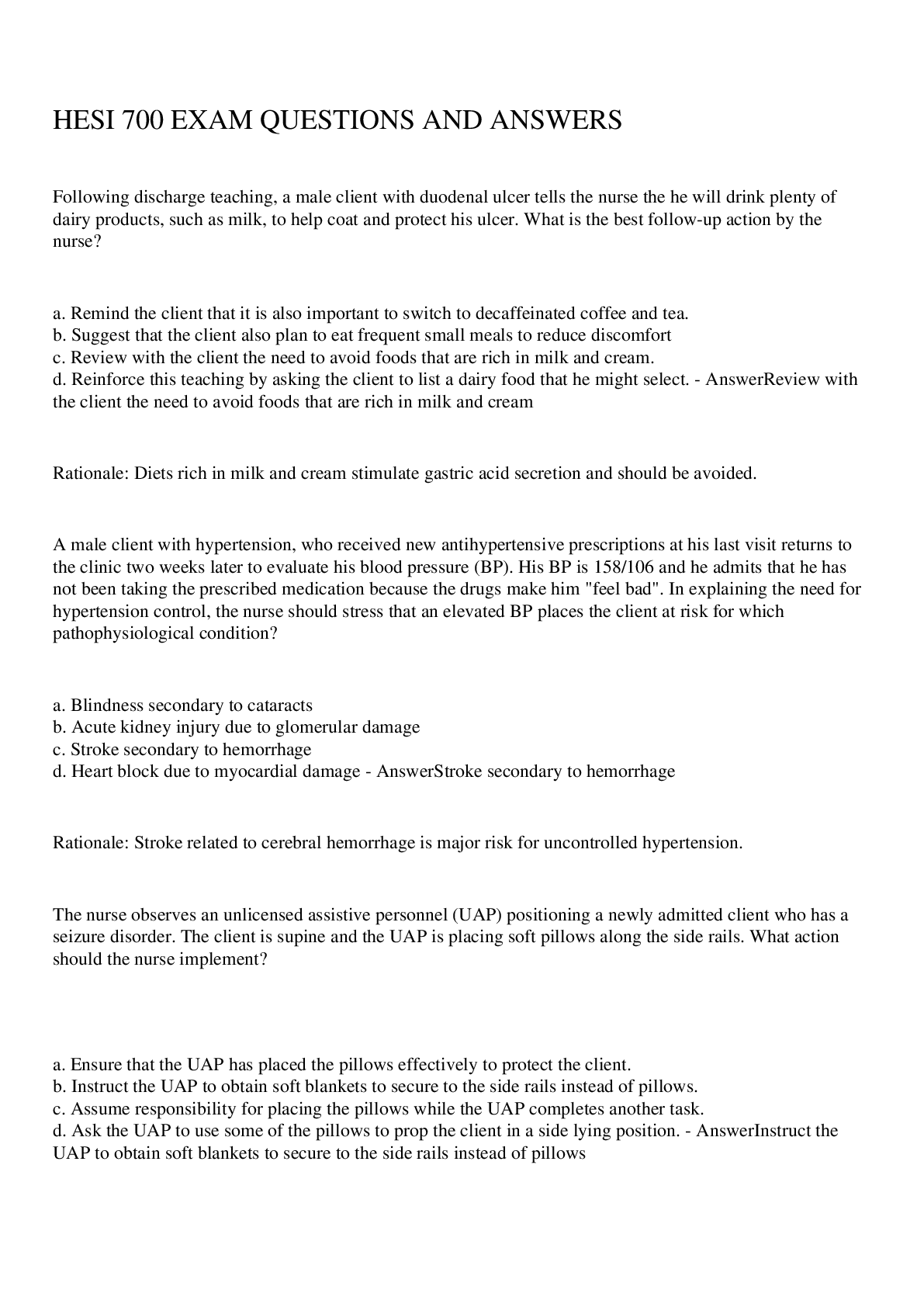
Reviews( 0 )
Document information
Connected school, study & course
About the document
Uploaded On
Jun 12, 2022
Number of pages
244
Written in
Additional information
This document has been written for:
Uploaded
Jun 12, 2022
Downloads
0
Views
203

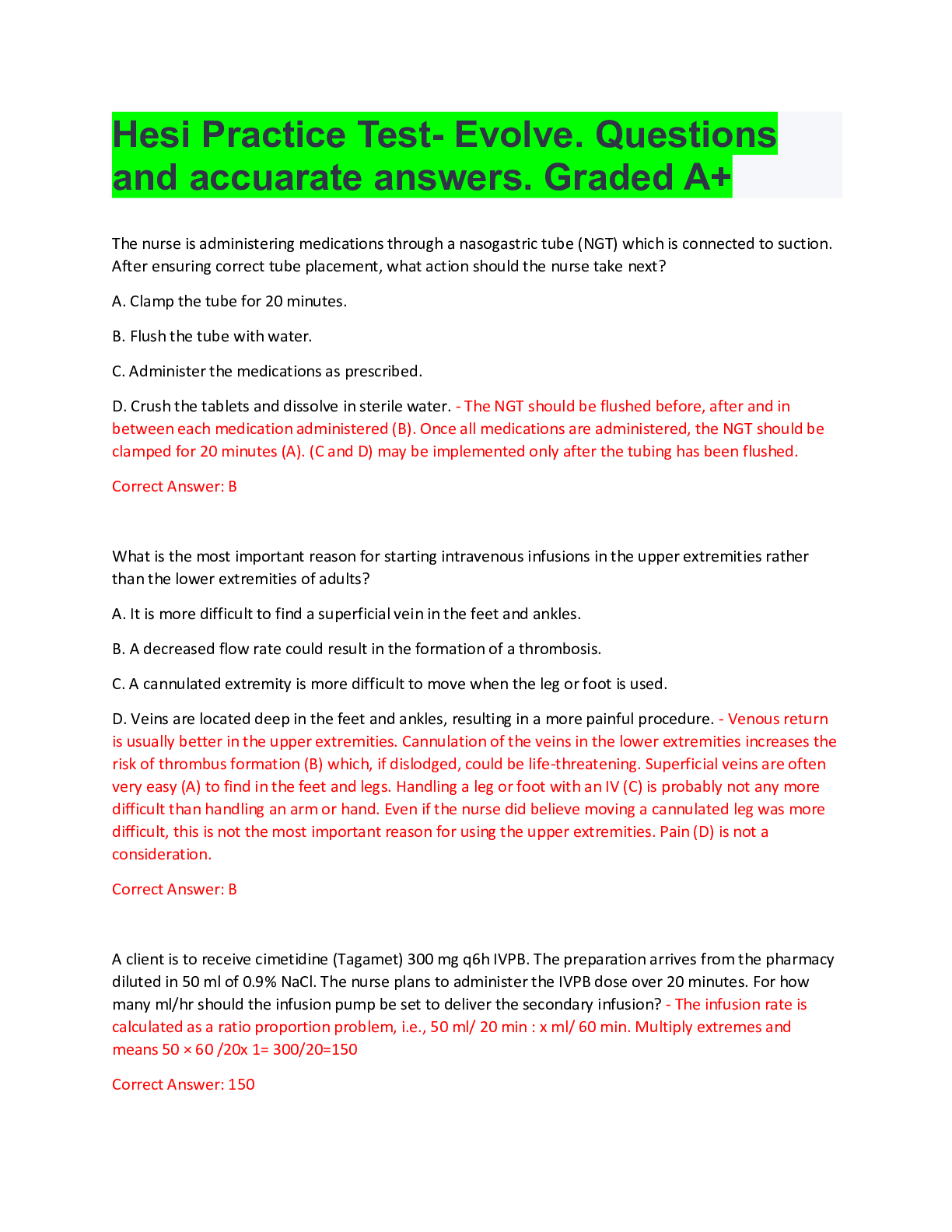
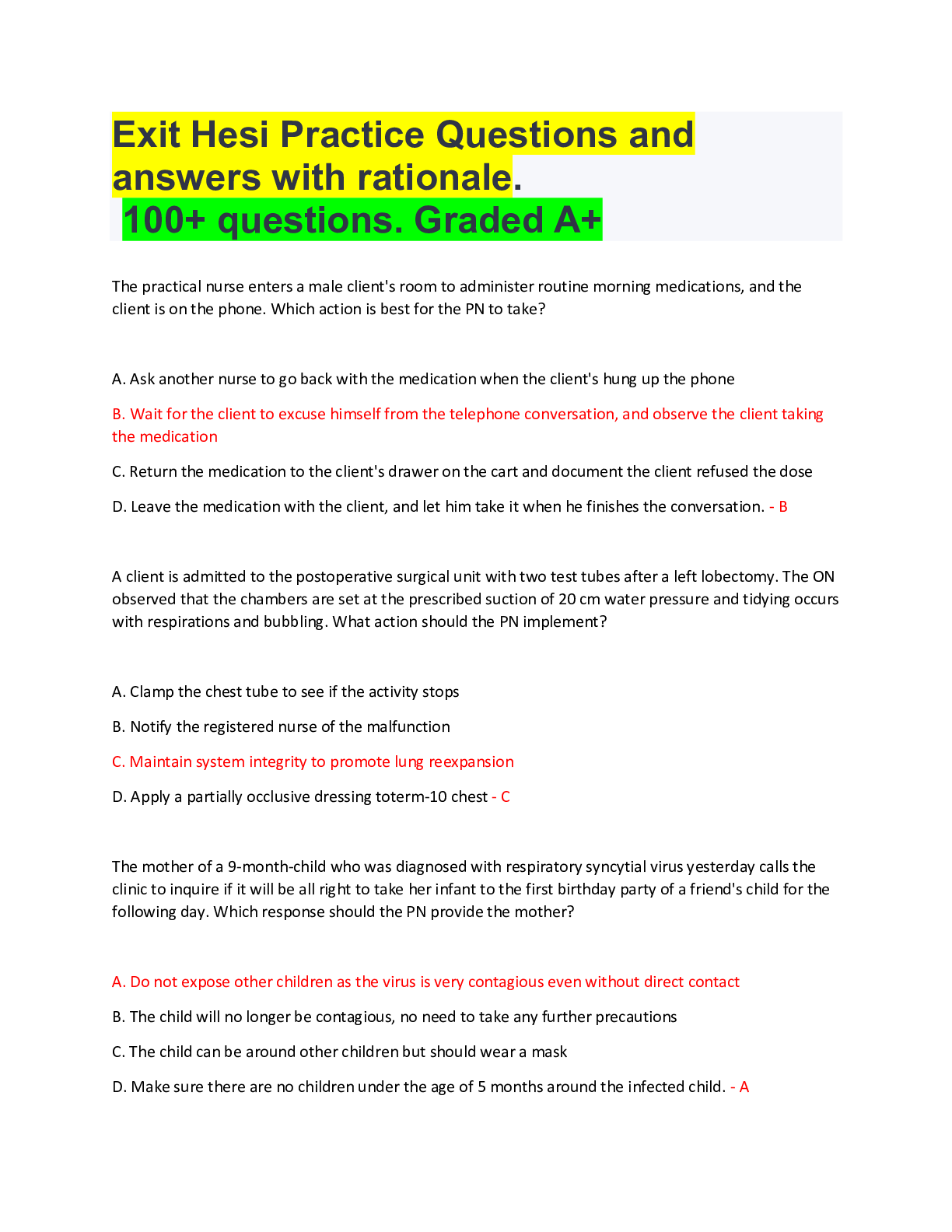

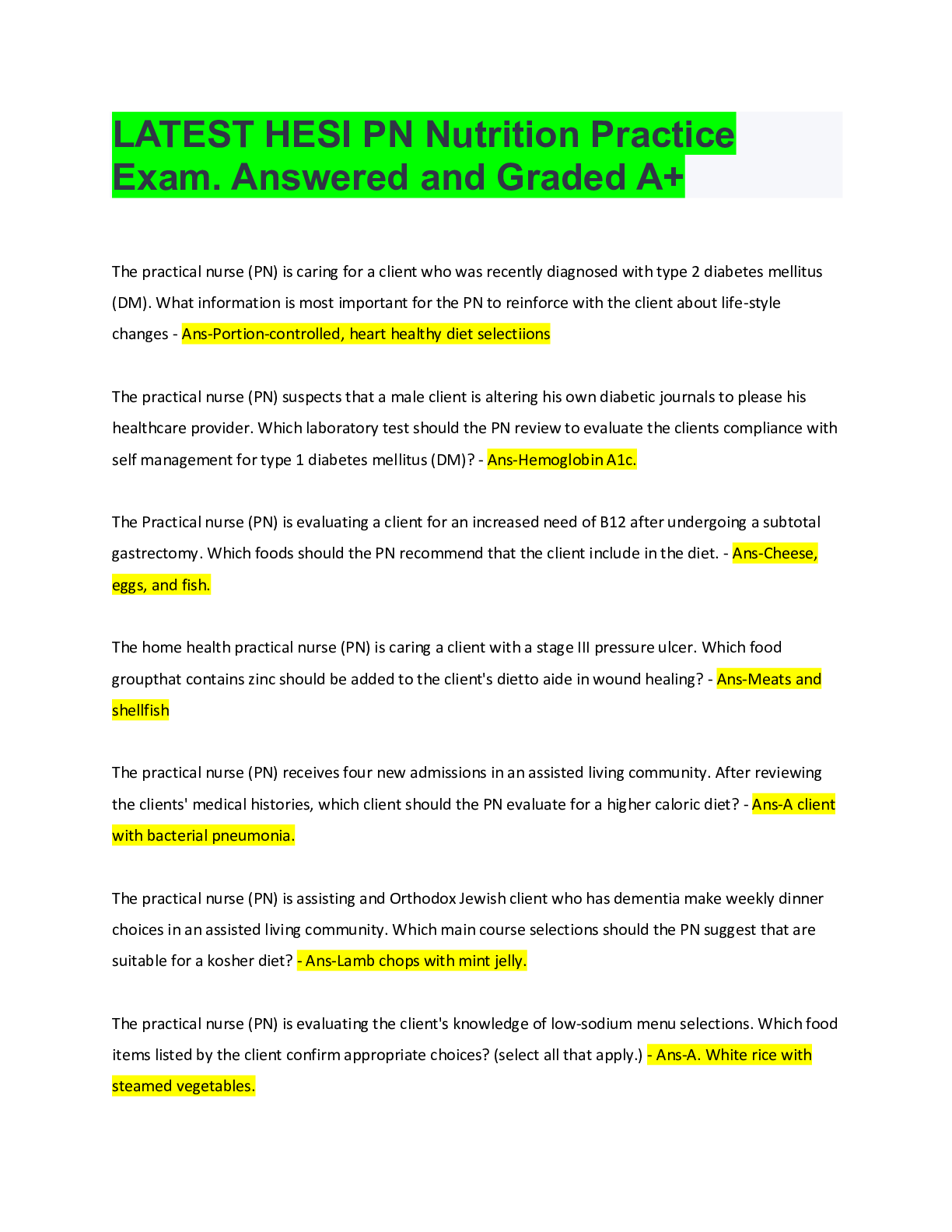




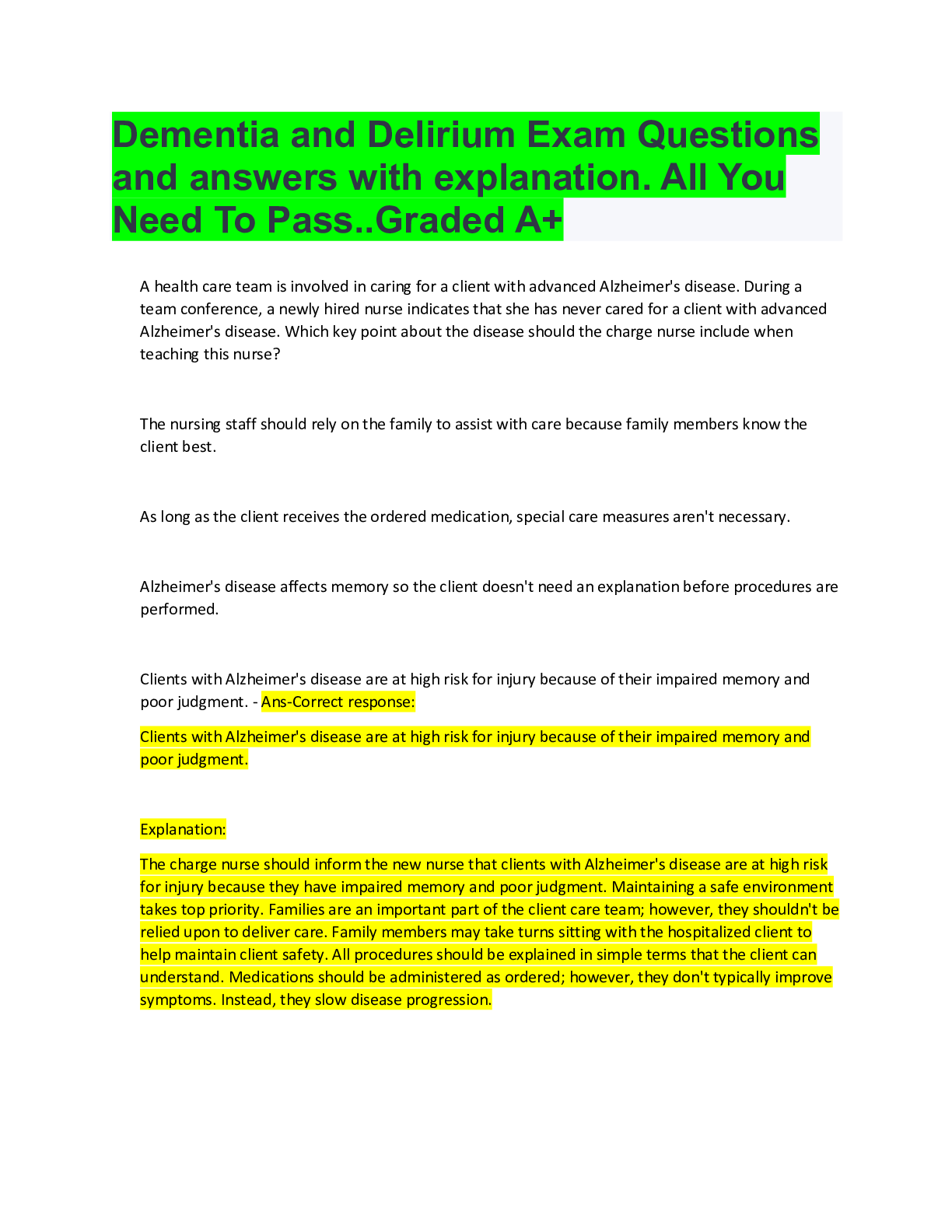


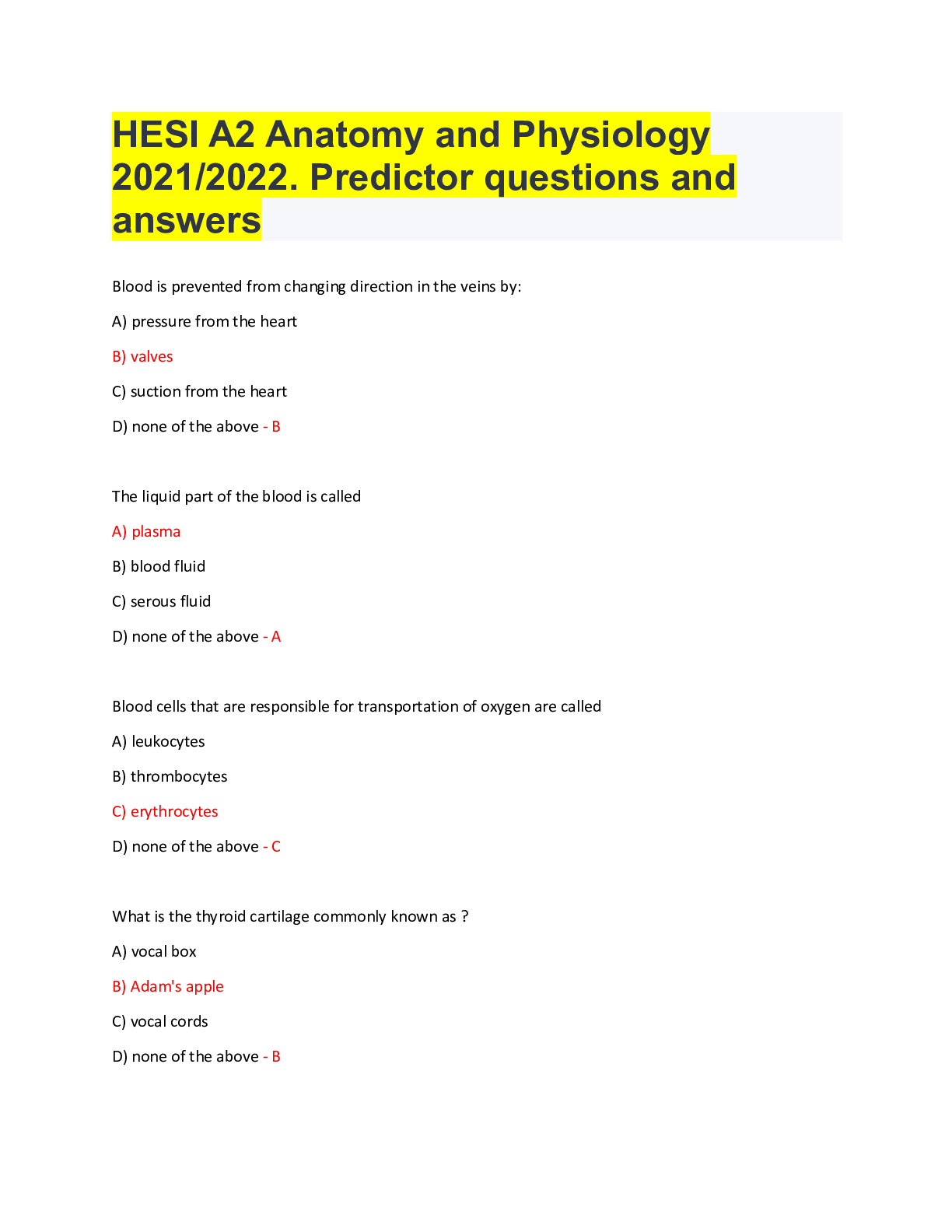

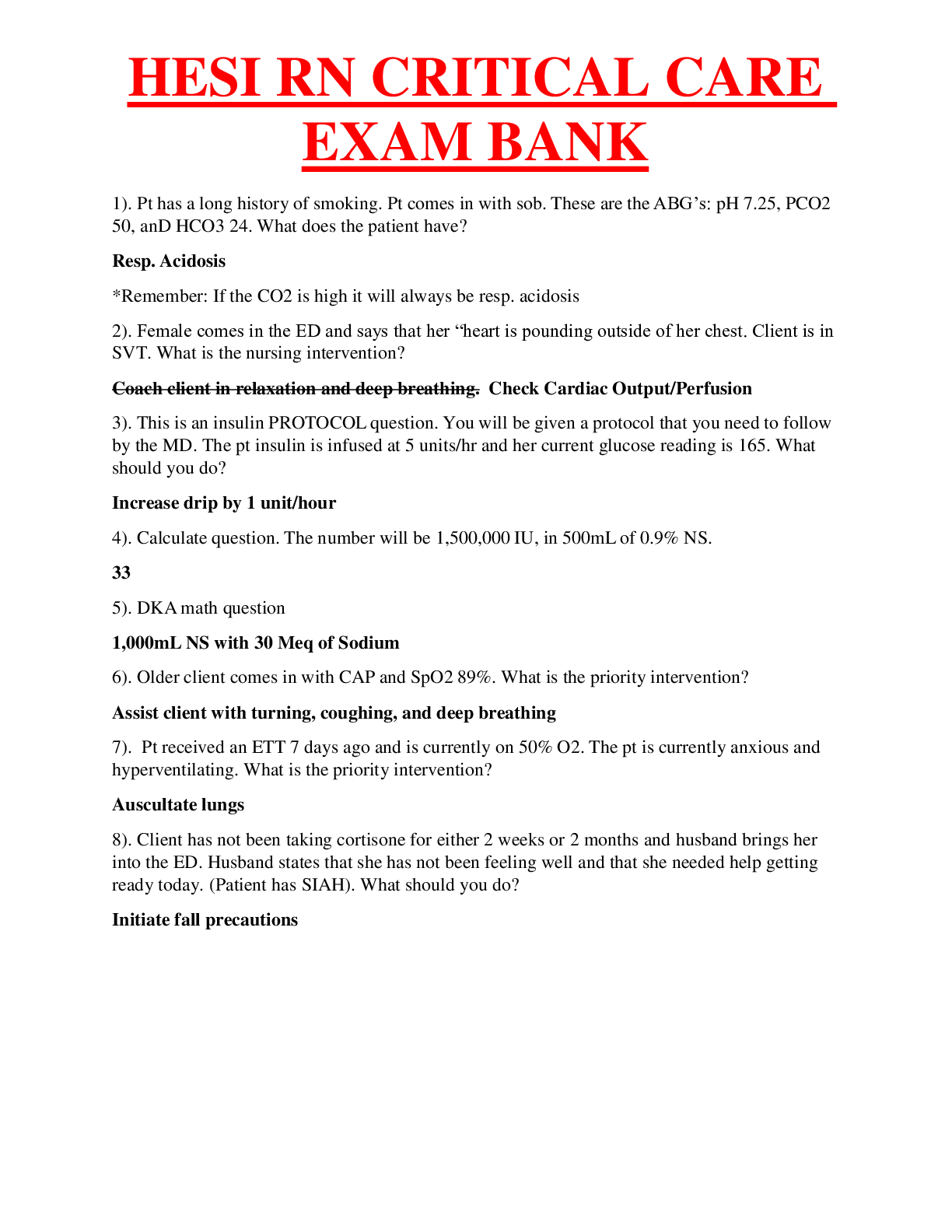
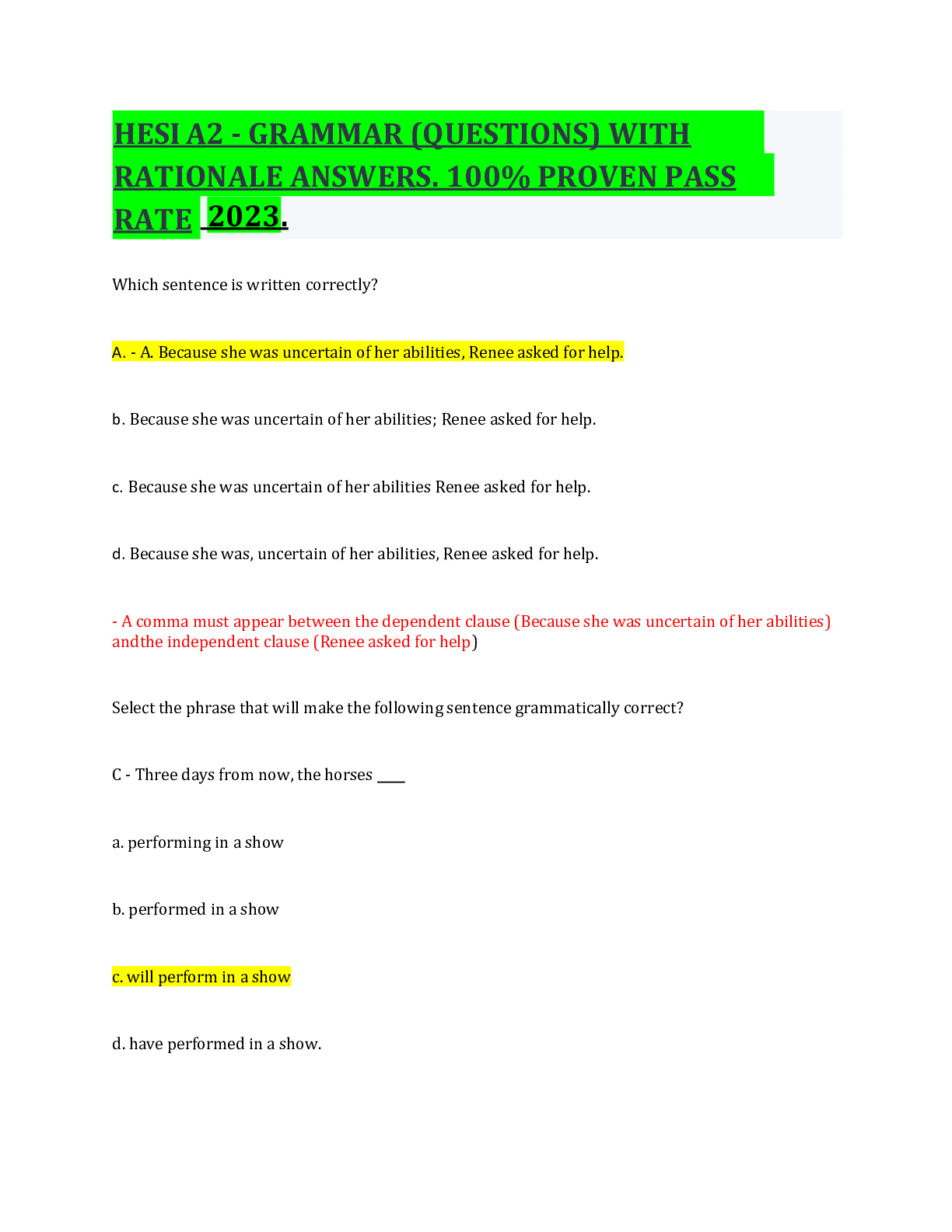
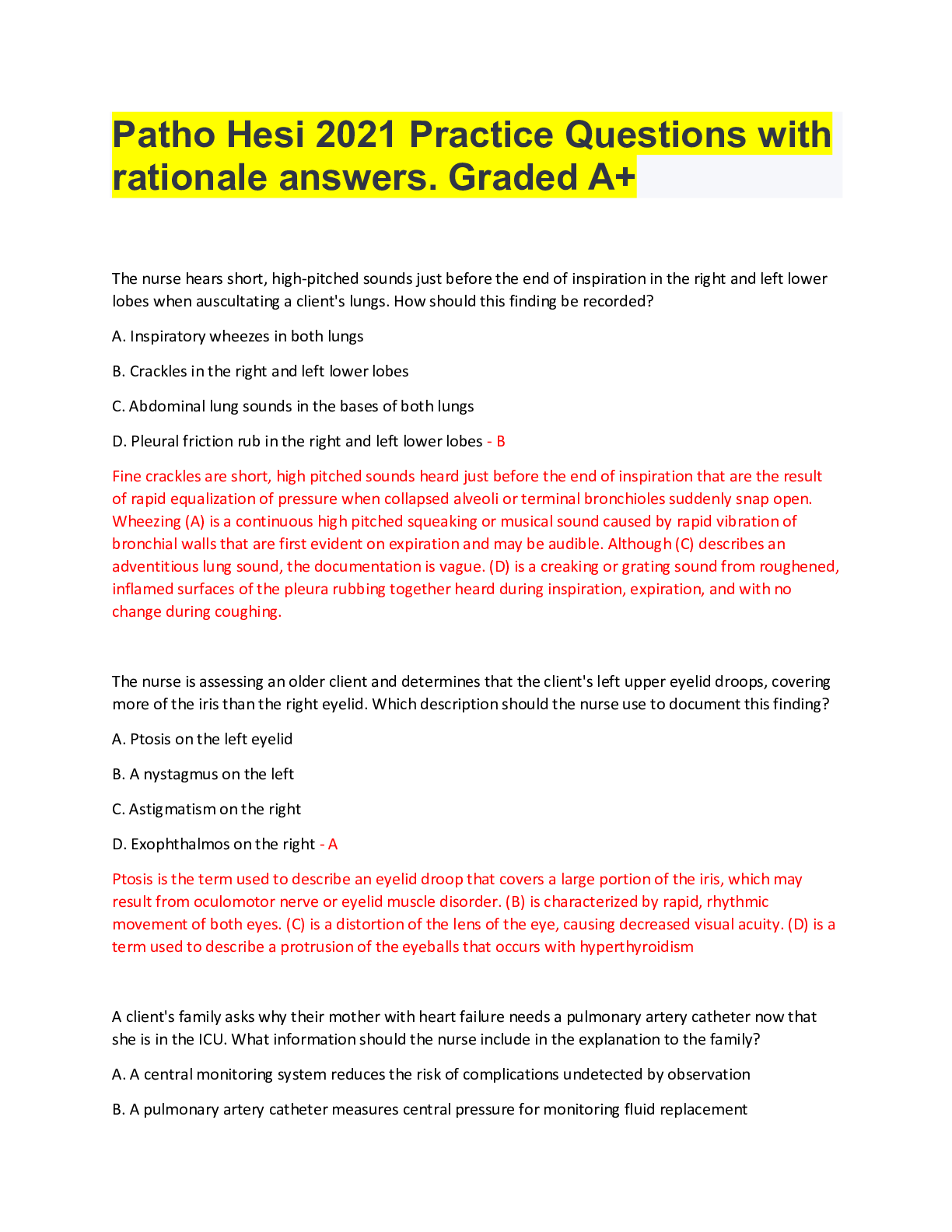
.png)
.png)
